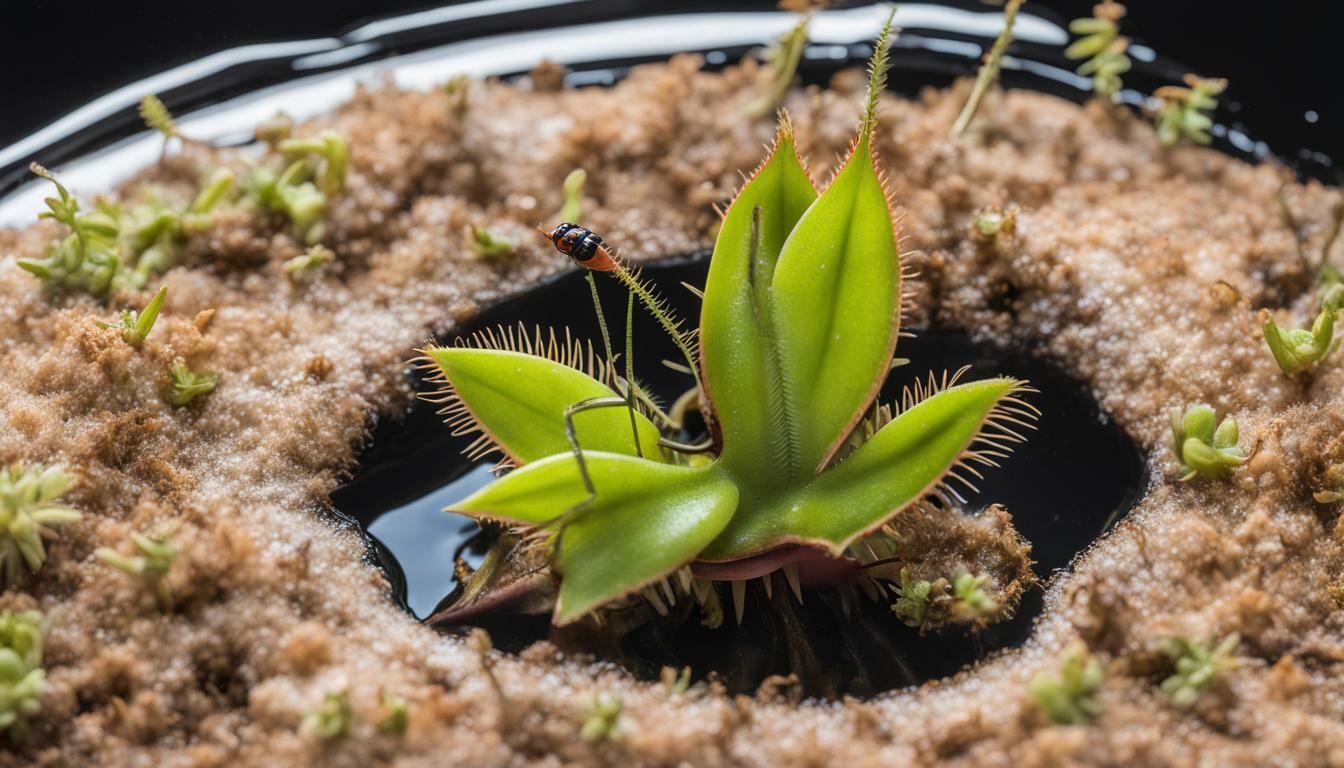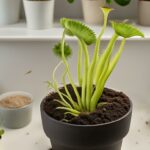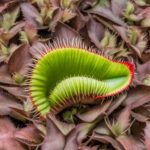If you’re a proud owner of a Venus flytrap, you might have experienced the sudden blackening of its leaves or traps after it fed on its prey. This can be concerning, as it may indicate a problem with your plant’s health. But why does this happen and what can you do to prevent it?
In this article, we’ll explore the reasons behind Venus flytrap discoloration and provide you with essential care tips to ensure your plant’s healthy growth. We’ll first address the main concern of why a Venus flytrap turns black after eating and then delve into the unique digestion process of the plant to help you understand how it works. We’ll also identify the various reasons that can cause blackening and offer solutions for resolving Venus flytrap eating problems.
Key Takeaways:
- Venus flytraps can turn black after eating due to a natural process of digestion.
- Understanding the Venus flytrap’s digestion process is essential to caring for your plant.
- Blackening can also be caused by stress, rotting, or fungal infections.
- Care tips such as proper feeding techniques and suitable prey options can promote healthy growth.
Understanding the Venus Flytrap Digestion Process
Have you ever wondered how a Venus flytrap digests its prey? The mechanism behind this unique process is fascinating. When an insect lands on the trap, it triggers the tiny hairs on the surface. As the insect struggles to escape, the trap closes, forming an airtight seal. This action prevents the insect from escaping and establishes an environment for the digestion process to begin.
After the trap closes, the Venus flytrap secretes digestive enzymes onto the prey. These enzymes start breaking down the insect’s exoskeleton and soft tissues. The nutrient-rich fluids are then absorbed into the plant, providing necessary nutrients for growth.
The Venus flytrap has a limited supply of enzymes, so it only digests a few insects before the trap dies. During this process, the leaves may turn black. However, this is not necessarily a cause for concern. It is a natural part of the digestion process and does not harm the plant.
| Venus Flytrap Digestion Process: | |
|---|---|
| Traps close when an insect lands | |
| Enzymes are secreted onto the prey | |
| Prey is broken down, and nutrients are absorbed into the plant | |
| Leaves may turn black during digestion |
It is essential to note that if the entire plant blackens, it may be a sign of stress, rotting or a fungal infection. In such cases, it is essential to take necessary measures to prevent further damage.
With this understanding of the Venus flytrap digestion process, you can appreciate the natural wonder of this mysterious plant and ensure proper care is taken for healthy growth.
Reasons for Venus Flytrap Blackening
If you notice your Venus flytrap turning black, there could be a number of reasons why it is happening. In this section, we will discuss some of the most common causes of Venus flytrap blackening, and what you can do to prevent or address the issue.
Venus Flytrap Stress
Stress is one of the most common causes of Venus flytrap blackening. Stress can occur when a Venus flytrap is exposed to extreme temperatures, lack of water, or changes in lighting conditions. When a flytrap is stressed, it will often stop growing and may develop black leaves or traps. To prevent stress, ensure your Venus flytrap is getting adequate water and is kept in stable temperature and lighting conditions.
Venus Flytrap Rotting
Venus flytraps are prone to rotting, especially if they are overwatered. When a flytrap is overwatered, the roots can become waterlogged, leading to root rot. This can cause the leaves or traps to turn black. To prevent rotting, ensure your Venus flytrap is getting watered properly and that the soil is well-draining.
Venus Flytrap Fungal Infection
Venus flytraps can also be susceptible to fungal infections, which can cause blackening. Fungal infections can occur when the soil is too moist, or if the flytrap is exposed to fungal spores. To prevent fungal infections, ensure that your flytrap is not overwatered and that the soil is well-draining. Additionally, avoid placing your Venus flytrap near other plants that may be infected with fungi.
By identifying the causes of Venus flytrap blackening, you can take steps to prevent or address the issue. Keep an eye on your plant’s growth and overall health, and make adjustments as needed. With proper care, your Venus flytrap can thrive and continue to captivate and fascinate you with its unique digestive process.
Resolving Venus Flytrap Eating Problems
If you’re experiencing issues with your Venus flytrap’s feeding habits, there are several strategies you can implement to promote healthy eating and growth.
Venus Flytrap Eating Issues
If your Venus flytrap is not eating or is rejecting prey, it may be due to stress or improper feeding techniques. To prevent stress, ensure that your plant is receiving adequate sunlight and water. Additionally, avoid touching the traps or providing it with prey that is too large to handle.
Improper feeding techniques may also contribute to eating issues. Avoid feeding your Venus flytrap with meat or insects that have been killed with insecticides or pesticides. Instead, choose live insects like ants, flies, or crickets.
Venus Flytrap Feeding Tips
Feeding your Venus flytrap properly is crucial for its growth and health. To ensure successful feeding, follow these tips:
- Choose prey that is small enough to fit into the trap.
- Avoid touching the trap or prey with your fingers.
- Place the prey inside the trap using a pair of tweezers or toothpick.
- Do not overfeed your Venus flytrap. It may only need to eat once every two to four weeks.
- Remove any prey that has not been eaten after a few days to prevent rotting, which can cause blackening.
Venus Flytrap Care
Proper care can help prevent eating problems and promote healthy growth for your Venus flytrap. Ensure that your plant is receiving adequate sunlight, water, and humidity. Additionally, avoid overfeeding or overhandling the traps.
It’s essential to use distilled water or rainwater when watering your Venus flytrap, as tap water can contain minerals that can harm the plant. Additionally, fertilizers or soil with high nutrient levels can also cause problems and should be avoided.
Venus Flytrap Healthy Growth
To promote healthy growth for your Venus flytrap, keep it in a well-lit location with at least four to six hours of direct sunlight per day. Additionally, ensure that it is planted in a well-draining mixture of sphagnum moss and perlite.
During the winter months, reduce watering and place the plant in a cooler environment to promote dormancy. This will help the plant conserve energy and prepare for the next growing season.
Venus Flytrap Discoloration Conclusion and Care Summary
By now, you understand that a Venus flytrap turning black after eating is a natural part of its digestion process. However, there are also several reasons why your plant may turn black and exhibit signs of stress or infection. Understanding these causes is the first step to resolving any eating problems your Venus flytrap may be experiencing.
To keep your Venus flytrap healthy and thriving, it is crucial to provide proper care. This means ensuring it has adequate sunlight, watering it with distilled water, and avoiding overfeeding. Venus flytraps consume very few nutrients, so feeding them too often can lead to rotting and fungal infections.
Additionally, it is best to only feed your Venus flytrap small insects, such as fruit flies or gnats. Avoid feeding it larger insects such as beetles or ants, as they can damage the plant’s traps or cause stress. If you notice signs of discoloration or stress, take action immediately by identifying the cause and implementing proper care practices.
Overall Care Tips for a Healthy Venus Flytrap
-Provide 4-6 hours of direct sunlight daily.
-Keep the soil moist, but not waterlogged.
-Use distilled water for watering.
-Avoid fertilizers and tap water.
-Only feed your Venus flytrap small insects.
-Do not overfeed.
-Ensure proper humidity levels.
-Identify and address any signs of discoloration or stress immediately.
By following these care tips and understanding the Venus flytrap digestion process, you can ensure your plant thrives and exhibits healthy growth for years to come.
Does a Venus Flytrap Take Longer to Digest If It Turns Black After Eating?
The venus flytrap’s fly consumption duration is not affected by the color change after eating. Despite turning black, the digestion process remains the same. Once a fly is caught, the flytrap secretes enzymes that break down the prey into nutrients. This process, although fascinating, does not depend on the appearance of the plant.
FAQ
Q: Why did my Venus flytrap turn black after eating?
A: The Venus flytrap turns black after eating due to its unique digestion process. When the plant captures and digests prey, it secretes enzymes that break down the insects, causing the plant to absorb nutrients. This absorption process leads to the discoloration of the leaves and traps.
Q: How does the Venus flytrap digestion process work?
A: The Venus flytrap captures its prey by closing its traps when triggered by movements. Once closed, the plant secretes digestive enzymes onto the insect, breaking it down into simpler compounds. The plant then absorbs these nutrients, resulting in the blackening of the leaves or traps.
Q: What are the reasons for Venus flytrap blackening?
A: There are several reasons why a Venus flytrap may turn black. Stress, such as inadequate light or water, can cause the plant to blacken. Rotting of prey within the traps or a fungal infection can also lead to discoloration. It’s important to address these issues promptly to maintain the plant’s health.
Q: How can I resolve Venus flytrap eating problems?
A: To resolve Venus flytrap eating problems, ensure that you are providing suitable prey options. Small insects like flies or ants work best. Avoid feeding the plant large or hard-to-digest prey. Additionally, maintain proper care practices such as providing adequate sunlight, watering with distilled water, and avoiding overfeeding to promote healthy growth.











